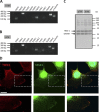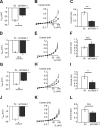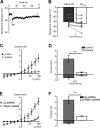TREK-1 channels regulate pressure sensitivity and calcium signaling in trabecular meshwork cells
- PMID: 30446509
- PMCID: PMC6279358
- DOI: 10.1085/jgp.201812179
TREK-1 channels regulate pressure sensitivity and calcium signaling in trabecular meshwork cells
Abstract
Mechanotransduction by the trabecular meshwork (TM) is an essential component of intraocular pressure regulation in the vertebrate eye. This process is compromised in glaucoma but is poorly understood. In this study, we identify transient receptor potential vanilloid isoform 4 (TRPV4) and TWIK-related potassium channel-1 (TREK-1) as key molecular determinants of TM membrane potential, pressure sensitivity, calcium homeostasis, and transcellular permeability. We show that resting membrane potential in human TM cells is unaffected by "classical" inhibitors of voltage-activated, calcium-activated, and inwardly rectifying potassium channels but is depolarized by blockers of tandem-pore K+ channels. Using gene profiling, we reveal the presence of TREK-1, TASK-1, TWIK-2, and THIK transcripts in TM cells. Pressure stimuli, arachidonic acid, and TREK-1 activators hyperpolarize these cells, effects that are antagonized by quinine, amlodipine, spadin, and short-hairpin RNA-mediated knockdown of TREK-1 but not TASK-1. Activation and inhibition of TREK-1 modulates [Ca2+]TM and lowers the impedance of cell monolayers. Together, these results suggest that tensile homeostasis in the TM may be regulated by balanced, pressure-dependent activation of TRPV4 and TREK-1 mechanotransducers.
© 2018 Yarishkin et al.
Figures









Comment in
-
Mechano-electrical transduction in trabecular meshwork involves parallel activation of TRPV4 and TREK-1 channels.Channels (Austin). 2019 Dec;13(1):168-171. doi: 10.1080/19336950.2019.1618149. Channels (Austin). 2019. PMID: 31161865 Free PMC article. No abstract available.
Similar articles
-
Trabecular Meshwork TREK-1 Channels Function as Polymodal Integrators of Pressure and pH.Invest Ophthalmol Vis Sci. 2019 May 1;60(6):2294-2303. doi: 10.1167/iovs.19-26851. Invest Ophthalmol Vis Sci. 2019. PMID: 31117121 Free PMC article.
-
Mechano-electrical transduction in trabecular meshwork involves parallel activation of TRPV4 and TREK-1 channels.Channels (Austin). 2019 Dec;13(1):168-171. doi: 10.1080/19336950.2019.1618149. Channels (Austin). 2019. PMID: 31161865 Free PMC article. No abstract available.
-
Piezo1 channels mediate trabecular meshwork mechanotransduction and promote aqueous fluid outflow.J Physiol. 2021 Jan;599(2):571-592. doi: 10.1113/JP281011. Epub 2020 Dec 12. J Physiol. 2021. PMID: 33226641 Free PMC article.
-
Molecular and functional properties of two-pore-domain potassium channels.Am J Physiol Renal Physiol. 2000 Nov;279(5):F793-801. doi: 10.1152/ajprenal.2000.279.5.F793. Am J Physiol Renal Physiol. 2000. PMID: 11053038 Review.
-
Two-Pore Domain Potassium Channel in Neurological Disorders.J Membr Biol. 2021 Aug;254(4):367-380. doi: 10.1007/s00232-021-00189-8. Epub 2021 Jun 24. J Membr Biol. 2021. PMID: 34169340 Review.
Cited by
-
TRPV4 activation by TGFβ2 enhances cellular contractility and drives ocular hypertension.Elife. 2025 Jun 24;14:RP104894. doi: 10.7554/eLife.104894. Elife. 2025. PMID: 40552711 Free PMC article.
-
TRPV4 controls circadian and pathological ocular hypertension.J Physiol. 2025 Jul;603(14):4091-4111. doi: 10.1113/JP288706. Epub 2025 Jul 10. J Physiol. 2025. PMID: 40638660 Free PMC article.
-
Mechanosensitive ion channel gene survey suggests potential roles in primary open angle glaucoma.Sci Rep. 2023 Sep 23;13(1):15871. doi: 10.1038/s41598-023-43072-3. Sci Rep. 2023. PMID: 37741866 Free PMC article.
-
Development of covalent chemogenetic K2P channel activators.bioRxiv [Preprint]. 2023 Oct 18:2023.10.15.561774. doi: 10.1101/2023.10.15.561774. bioRxiv. 2023. Update in: Cell Chem Biol. 2024 Jul 18;31(7):1305-1323.e9. doi: 10.1016/j.chembiol.2024.06.006. PMID: 37905049 Free PMC article. Updated. Preprint.
-
TRPV4 subserves physiological and pathological elevations in intraocular pressure.Res Sq [Preprint]. 2024 Jul 12:rs.3.rs-4714050. doi: 10.21203/rs.3.rs-4714050/v1. Res Sq. 2024. PMID: 39041037 Free PMC article. Preprint.
References
Publication types
MeSH terms
Substances
Grants and funding
LinkOut - more resources
Full Text Sources
Miscellaneous

